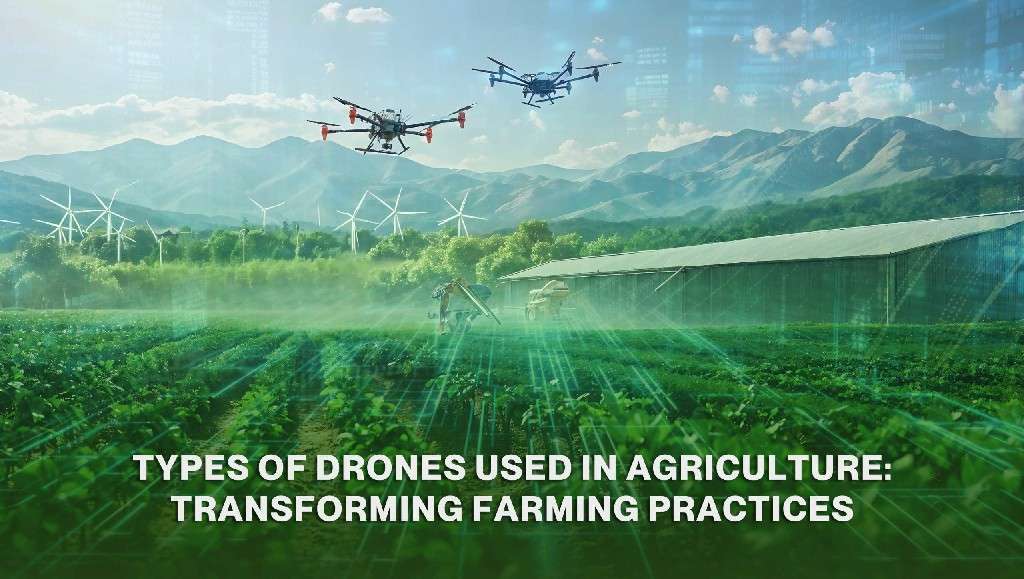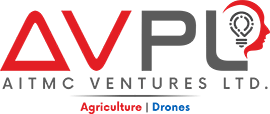
Types of Drones Used in Agriculture: Transforming Farming Practices
In this blog, we will explore the different types of drones used in agriculture, their applications, and how they are transforming the industry. Whether it’s crop monitoring, field mapping, or spraying, drones are changing how farmers manage their land, conserve resources, and improve productivity.
Section 1: What Are Agricultural Drones?
Agricultural drones, or agri-drones or farming drones, are uncrewed aerial vehicles (UAVs) designed explicitly for use in the agricultural sector. The best agricultural drone company equips these drones with advanced sensors and imaging capabilities, allowing them to perform a wide range of tasks, from surveying large farmland areas to applying pesticides and fertilizers with pinpoint accuracy.
Compared to traditional farming methods that rely on human labor and machinery, drones from the best agricultural drone company offer a level of precision and efficiency that was previously unattainable. With the ability to cover vast areas in a short amount of time, these drones are becoming indispensable tools for modern farmers.
The Role of Drones in Agriculture
Agricultural drones can be equipped with a variety of sensors, cameras, and spraying systems, allowing them to perform numerous functions such as:
- Crop monitoring: Drones can fly over vast areas and provide real-time data on plant health, soil conditions, and water levels.
- Field mapping: Drones create detailed 3D maps of fields, helping farmers better understand their land and plan planting, irrigation, and harvesting.
- Spraying: Drones equipped with sprayers can apply fertilizers, pesticides, and herbicides directly to crops, improving efficiency and reducing waste.
- Precision farming: By gathering accurate data, drones help farmers make informed decisions on crop management, ensuring optimal resource usage.
1. Multirotor Drones
- Crop Monitoring: Multirotor drones are perfect for inspecting crops closely. They can hover at low altitudes and capture high-resolution images, revealing details about plant health, such as diseases, pests, or nutrient deficiencies.
- Spraying Pesticides and Fertilizers: Some multirotor drones have spraying systems that allow them to apply fertilizers, pesticides, or herbicides to crops with pinpoint accuracy. This reduces chemical waste and ensures even coverage.
- Irrigation Monitoring: Multirotor drones can detect areas of the field that are overwatered or underwatered using infrared sensors, helping farmers optimize irrigation schedules and reduce water usage.
- Precision and Stability: Multirotor drones offer high accuracy, making them ideal for tasks requiring careful maneuvering in small areas.
- Ease of Use: These drones are relatively easy to control, even for beginners, and their ability to hover in place makes them ideal for detailed inspections.
- Affordable: Multirotor drones are generally more affordable than other drones, making them accessible to small and medium-sized farms.
- Limited Flight Time: Due to their design, multirotor drones typically have shorter flight times than fixed-wing drones, making them less suitable for covering large areas.
- Lower Speed:These drones are slower than fixed-wing drones, which may affect their efficiency on larger farms.
2. Fixed-Wing Drones
- Field Mapping: Fixed-wing drones are commonly used to create detailed maps of large agricultural areas. By flying over the land and capturing images from above, they generate precise topographical data, helping farmers understand the layout and characteristics of their fields.
- Crop Monitoring: While fixed-wing drones cannot hover like multirotor drones, they can still capture valuable data on crop health by flying at high altitudes, making them suitable for large-scale crop monitoring.
- Soil Analysis: Fixed-wing drones can carry specialized sensors that measure soil moisture, temperature, and other conditions, providing farmers with insights into the health of their land.
- Advantages
- Longer Flight Times: Fixed-wing drones can stay airborne for extended periods, allowing them to cover larger areas in a single flight. This makes them ideal for large farms and extensive field mapping.
- Higher Speeds: These drones are faster than multirotor drones, enabling them to complete tasks over long distances quickly.
- Less Precision: Fixed-wing drones are less precise than multirotor drones for localized tasks, such as spraying specific crops or conducting close-up inspections.
- More Complex to Operate: These drones require more advanced piloting skills, and their takeoff and landing processes are more complex than those of multirotor drones.
3. Hybrid Drones
- Field Mapping and Monitoring: Hybrid drones are excellent for surveying large areas and capturing data on crop health, soil conditions, and irrigation needs. Their ability to cover extensive fields while providing detailed data makes them valuable for precision farming.
- Spraying: Hybrid drones can be equipped with spraying systems to treat crops efficiently, especially in large fields requiring precision and speed.
- Long-Range Missions: For farmers with expansive fields, hybrid drones offer the ability to cover long distances while still performing close-up tasks when necessary.
- Versatility: Hybrid drones offer the best of both worlds, covering large areas like fixed-wing drones while maintaining the precision and flexibility of multirotor drones.
- Longer Flight Times: Hybrid drones typically have longer flight times than multirotor drones, making them more suitable for large-scale operations.
- Adaptability:These drones can be used for various tasks, from field mapping to crop spraying, making them highly adaptable to different farming needs.
- Higher Cost: Their advanced design makes hybrid drones more expensive than multirotor or fixed-wing drones.
- Complex Operation: Operating hybrid drones requires more training and expertise than simpler multirotor drones.
4. Spraying Drones
Spraying drones are specialized agricultural drones designed to apply fertilizers, pesticides, herbicides, and other chemicals to crops. These drones are equipped with tanks and nozzles that spray chemicals evenly across the fields. Spraying drones can be either multirotor or hybrid in design, depending on the size of the area they are intended to cover.
- Pesticide Application: Spraying drones apply pesticides to crops, reducing the risk of pests damaging the plants.
- Fertilizer Application: These drones help distribute fertilizers evenly across fields, ensuring every plant receives the nutrients it needs to grow.
- Weed Control: Spraying drones can also apply herbicides to control weeds, ensuring they do not compete with crops for nutrients and sunlight.
- Precision Application: Spraying drones apply highly precise chemicals, ensuring that crops receive the correct dosage while minimizing waste and environmental impact.
- Time Efficiency: Spraying drones can cover large areas quickly, saving farmers time and reducing the need for manual labor.
- High Cost: Spraying drones can be expensive, especially those designed for large-scale operations.
- Regulatory Challenges: Depending on the region, strict regulations may govern the use of drones for spraying chemicals, which can limit their deployment.
5. Mapping Droness
Applications in Agriculture
- Field Mapping: Mapping drones provide farmers with accurate representations of their land, helping them identify variations in soil quality, water distribution, and crop health.
- Plant Health Monitoring: By analyzing the images captured by mapping drones, farmers can detect areas where plants may be under stress due to disease, pests, or nutrient deficiencies.
Advantages
- High-Resolution Data: Mapping drones provide farmers with highly detailed maps that offer valuable insights into the condition of their fields.
- Improved Decision-Making: The data collected by mapping drones helps farmers make informed decisions about planting, irrigation, and crop management.
Disadvantages
- Limited to Mapping: While mapping drones provide valuable data, they are restricted to surveying and mapping tasks and cannot perform other functions like spraying or close-up inspections.

